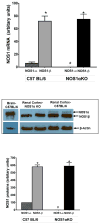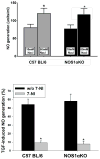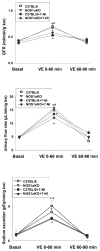Inhibition of Nitric Oxide Synthase 1 Induces Salt-Sensitive Hypertension in Nitric Oxide Synthase 1α Knockout and Wild-Type Mice
- PMID: 26883268
- PMCID: PMC4802158
- DOI: 10.1161/HYPERTENSIONAHA.115.07032
Inhibition of Nitric Oxide Synthase 1 Induces Salt-Sensitive Hypertension in Nitric Oxide Synthase 1α Knockout and Wild-Type Mice
Abstract
We recently showed that α, β, and γ splice variants of neuronal nitric oxide synthase (NOS1) expressed in the macula densa and NOS1β accounts for most of the NO generation. We have also demonstrated that the mice with deletion of NOS1 specifically from the macula densa developed salt-sensitive hypertension. However, the global NOS1 knockout (NOS1KO) strain is neither hypertensive nor salt sensitive. This global NOS1KO strain is actually an NOS1αKO model. Consequently, we hypothesized that inhibition of NOS1β in NOS1αKO mice induces salt-sensitive hypertension. NOS1αKO and C57BL/6 wild-type (WT) mice were implanted with telemetry transmitters and divided into 7-nitroindazole (10 mg/kg/d)-treated and nontreated groups. All of the mice were fed a normal salt (0.4% NaCl) diet for 5 days, followed by a high-salt diet (4% NaCl). NO generation by the macula densa was inhibited by >90% in WT and NOS1αKO mice treated with 7-nitroindazole. Glomerular filtration rate in conscious mice was increased by ≈ 40% after a high-salt diet in both NOS1αKO and WT mice. In response to acute volume expansion, glomerular filtration rate, diuretic and natriuretic response were significantly blunted in the WT and knockout mice treated with 7-nitroindazole. Mean arterial pressure had no significant changes in mice fed a high-salt diet, but increased ≈ 15 mm Hg similarly in NOS1αKO and WT mice treated with 7-nitroindazole. We conclude that NOS1β, but not NOS1α, plays an important role in control of sodium excretion and hemodynamics in response to either an acute or a chronic salt loading.
Keywords: 7-nitroindazole; arterial pressure; hypertension; sodium; telemetry.
© 2016 American Heart Association, Inc.
Figures





Similar articles
-
New Mechanism for the Sex Differences in Salt-Sensitive Hypertension: The Role of Macula Densa NOS1β-Mediated Tubuloglomerular Feedback.Hypertension. 2020 Feb;75(2):449-457. doi: 10.1161/HYPERTENSIONAHA.119.13822. Epub 2019 Dec 23. Hypertension. 2020. PMID: 31865794 Free PMC article.
-
Macula Densa Nitric Oxide Synthase 1β Protects against Salt-Sensitive Hypertension.J Am Soc Nephrol. 2016 Aug;27(8):2346-56. doi: 10.1681/ASN.2015050515. Epub 2015 Dec 8. J Am Soc Nephrol. 2016. PMID: 26647426 Free PMC article.
-
Macula Densa Nitric Oxide Synthase 1 Controls Renin Release and Renin-Dependent Blood Pressure Changes.Discov Med. 2023 Aug;35(177):525-532. doi: 10.24976/Discov.Med.202335177.53. Discov Med. 2023. PMID: 37553306 Free PMC article.
-
Role of macula densa neuronal nitric oxide synthase in renal diseases.Med Mol Morphol. 2006 Mar;39(1):2-7. doi: 10.1007/s00795-006-0310-2. Med Mol Morphol. 2006. PMID: 16575507 Review.
-
Nitric oxide and the A and B of endothelin of sodium homeostasis.Curr Opin Nephrol Hypertens. 2013 Jan;22(1):26-31. doi: 10.1097/MNH.0b013e32835b4edc. Curr Opin Nephrol Hypertens. 2013. PMID: 23160444 Free PMC article. Review.
Cited by
-
Cross-sex transplantation alters gene expression and enhances inflammatory response in the transplanted kidneys.Am J Physiol Renal Physiol. 2017 Aug 1;313(2):F326-F338. doi: 10.1152/ajprenal.00039.2017. Epub 2017 May 17. Am J Physiol Renal Physiol. 2017. PMID: 28515172 Free PMC article.
-
Renal sodium handling and sodium sensitivity.Kidney Res Clin Pract. 2017 Jun;36(2):117-131. doi: 10.23876/j.krcp.2017.36.2.117. Epub 2017 Jun 30. Kidney Res Clin Pract. 2017. PMID: 28680820 Free PMC article. Review.
-
Synergistic Network Pharmacology for Traditional Chinese Medicine Liangxue Tongyu Formula in Acute Intracerebral Hemorrhagic Stroke.Neural Plast. 2021 Feb 26;2021:8874296. doi: 10.1155/2021/8874296. eCollection 2021. Neural Plast. 2021. PMID: 33727915 Free PMC article.
-
New Mechanism for the Sex Differences in Salt-Sensitive Hypertension: The Role of Macula Densa NOS1β-Mediated Tubuloglomerular Feedback.Hypertension. 2020 Feb;75(2):449-457. doi: 10.1161/HYPERTENSIONAHA.119.13822. Epub 2019 Dec 23. Hypertension. 2020. PMID: 31865794 Free PMC article.
-
Knockout of Na+-glucose cotransporter SGLT1 mitigates diabetes-induced upregulation of nitric oxide synthase NOS1 in the macula densa and glomerular hyperfiltration.Am J Physiol Renal Physiol. 2019 Jul 1;317(1):F207-F217. doi: 10.1152/ajprenal.00120.2019. Epub 2019 May 15. Am J Physiol Renal Physiol. 2019. PMID: 31091127 Free PMC article.
References
-
- Fields LE, Burt VL, Cutler JA, Hughes J, Roccella EJ, Sorlie P. The burden of adult hypertension in the United States 1999 to 2000: a rising tide. Hypertension. 2004;44:398–404. - PubMed
-
- Vasan RS, Beiser A, Seshadri S, Larson MG, Kannel WB, D’Agostino RB, Levy D. Residual lifetime risk for developing hypertension in middle-aged women and men. The Framingham Heart Study. JAMA. 2002;287:1003–1010. - PubMed
-
- Weinberger MH. Salt sensitivity of blood pressure in humans. Hypertension. 1996;27:481–490. - PubMed
-
- Luft FC. Salt and hypertension: recent advances and perspectives. J Lab Clin Med. 1989;114:215–221. - PubMed
-
- Guyton AC, Young DB, DeClue JW, Ferguson JD, McCaa RE, Cevese A, Trippodo NC, Hall JE. The role of the kidney in hypertension. In: Berglund G, Hansson L, Werkö L, editors. Pathophysiology and Management of Arterial Hypertension; Proceedings of a Conference; Copenhagen, Denmark. April 10–11, 1975; Molndal, Sweden: A. Lindgren & Soner AB; 1975. pp. 78–89.
Publication types
MeSH terms
Substances
Grants and funding
LinkOut - more resources
Full Text Sources
Other Literature Sources
Medical
Molecular Biology Databases

